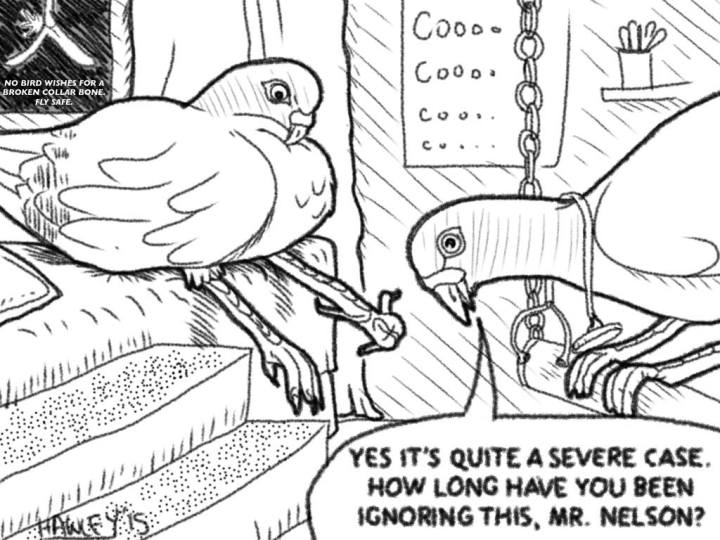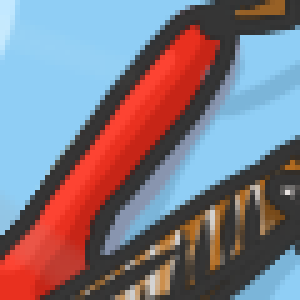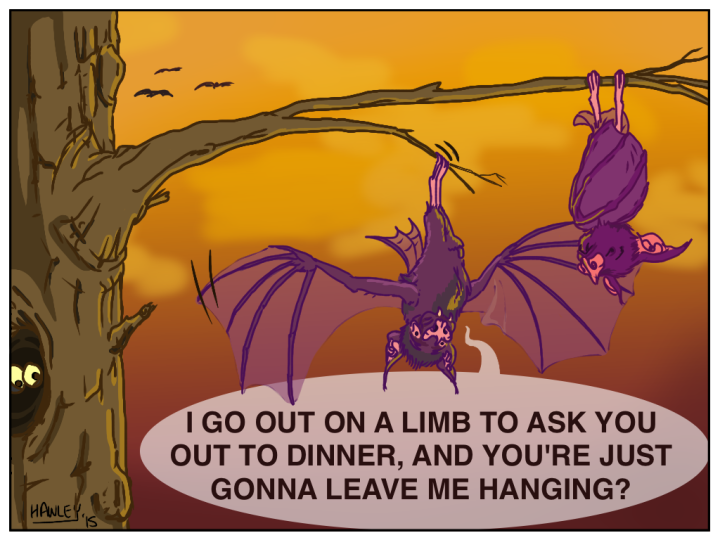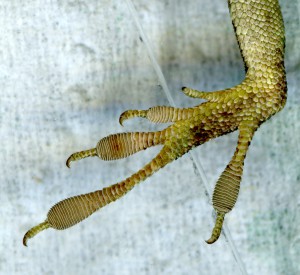 I was sitting, watching the pigeons at the train station and noticed how many of them have illnesses and disabilities. There were sooty ones, fluffed ragged ones, toeless, and footless ones. There are millions of ailing birds and no one seems to notice them much. I’m sure there are a lot of people who do, but it’s not too apparent. I was just imagining the state of the healthcare system if pigeons were people. Pigeons just seem to get on with it, even being footless. It reminded me of stories I’ve heard of patients letting their wounds reach their peak horror levels before they seek help, and then the doctor is faced with some horrific unchecked ailment. That’s the rationale for this drawing. Not too funny. Just a bit sad really.
I was sitting, watching the pigeons at the train station and noticed how many of them have illnesses and disabilities. There were sooty ones, fluffed ragged ones, toeless, and footless ones. There are millions of ailing birds and no one seems to notice them much. I’m sure there are a lot of people who do, but it’s not too apparent. I was just imagining the state of the healthcare system if pigeons were people. Pigeons just seem to get on with it, even being footless. It reminded me of stories I’ve heard of patients letting their wounds reach their peak horror levels before they seek help, and then the doctor is faced with some horrific unchecked ailment. That’s the rationale for this drawing. Not too funny. Just a bit sad really.
Living by myself cartoon
Standard This is my most recent cartoon after a long art drought (a few months).
This is my most recent cartoon after a long art drought (a few months).
I started this drawing before I moved out, and finished it at my new place (where the scene is modelled from). I’ve been doing a lot of landscape painting recently, and tried to implement some of the techniques I’ve been using in this cartoon.
I tried to use the colours of reflected light on surfaces that would reflect light nicely. This is minor, but my red lacquered bass is reflecting red light onto my blue shirt, creating a reddish-purplish light.
This is quite strange: that apparently reddish-purplish reflected light on the shirt is actually grey with very little red. I think I inadvertently created a colour illusion, possibly ‘colour constancy‘.
No wonder why I have so much trouble identifying and working with colours, and no wonder the blue-black, white-gold dress thing took off.
I also used a little bit of half-opacity colour like the light coming through the window, the pipe smoke, and the light coming from my computer screen.
It’s not quite clear but there are musical notes and a pair of waltzers in my pipe smoke. My book-writing self is munching on a celery stick, also unclear.
I’m not quite satisfied with the colour combination of the Tamagotchi. I initially had a pink and yellow combo, which looked good, but was too vibrant. I wanted something that was consistent with the top panel, but that had a feeling of unease and misery (which I don’t have, but which helps the joke), thus blue and purple.
They’re my unnecessary words for an otherwise simple cartoon.
CSIRO work — New Horizons comic and Sydney volcanoes diagram
StandardIn the last few weeks some great news and research has come out of the CSIRO, especially a fortnight ago when they were a part of the New Horizons mission to Pluto, and when their research vessel — RV Investigator — discovered a chain of massive underwater volcanoes off the coast of Sydney.
A few weeks before the #PlutoFlyby, I was commissioned by the communications team of the Canberra Deep Space Communication Complex to draw up a comic strip of how CSIRO was involved in the mission, and how New Horizons was communicating its data back to Earth.
They were looking for a comic format, which is ideal for my experience and pleasure!
I received a great initial concept sketch from the team from which I produced this draft sketch:
 They were quite happy with this and so after implementing their suggestions and changes, I used it as the foundation for the final version. And since it’s digital, I could go right over this draft with the final lines.
They were quite happy with this and so after implementing their suggestions and changes, I used it as the foundation for the final version. And since it’s digital, I could go right over this draft with the final lines.
 I’m quite happy with the final version. As usual, it took 2.5x longer than anticipated. Oh well, I had fun.
I’m quite happy with the final version. As usual, it took 2.5x longer than anticipated. Oh well, I had fun.
A day or two following the big Pluto reveal was another, more terrestrial, one: the Sydney Volcanoes. This was a great and strange discovery. It was fun in my mind since I’ve always imagined Australia as having a relatively stable geological temperament. What made the discovery more immense was the size of the cluster. They were kilometers wide and hundreds of metres high. I had trouble imagining what this meant so I used Google Maps to find a sector(?) of the Sydney CBD from around Sydney Tower to the Shangri-La/Circular Quay.
It’s a very rough comparison, since it was difficult getting standardised measurements of the city slice. The volcano used in this comparison is one of the smaller ones, but one with a larger or the largest caldera (opening at the top). It was fun to do, and I’d like to work on more comparisons in the future.
Slacks Creek Oil Painting and Time-lapse
StandardMy next commission is for the Logan City Council in Queensland, who are restoring Slacks Creek, a tributary of Logan River.
Due to land clearing and the build up of waste-water, the river’s health has declined severely. The council aims to develop native floral successions from the river, to the bank, and beyond. They’re planning on implementing citizen science, ongoing water testing, and monitoring of the local bull sharks.
Since I’m yet to fully dive into the world of digital animation, I thought I’d do an ‘analogue’ time-lapse painting of the creek. I chose oil as it’s a rich and evocative medium, albeit hard to handle.
The council initially wanted me to represent the creek as it went through the various stages of restoration, weeding, cleaning, replanting, etc.
To capture this process through paint, I thought it might be interesting to use clear acetate and do multiple paintings and layer them over each other to suggest time passing: 1) Dilapidated creek, 2) Repairing creek, and 3) Restored creek.
I thought I’d film the paintings on time-lapse, and then layer them together for the finale. The time-lapse footage will feature on the creek restoration project’s website. The final scene will be a composite of the three paintings, with each component of the painting hyperlinked to the relevant pages on the site: tree planting, citizen science, shark tagging etc.
Here’s a sketch with and without annotations of the previous, unhealthy phase of the creek.
And here’s a sketch of the creek post-restoration:
For this final panel, it will be a feat to include the various components of the project plus the plenitude of plant species. The prospect is daunting and exciting.
Here’s a quick oil paint mock-up of a banksia with a larger resolution than it will appear in the final painting/animation. And here is a sketch of the various activities to be featured in the final frame:
I’ll link to the piece when it’s finished 🙂
Oil painting — my earliest oiliest expeditions
StandardWith a big oil painting project coming up, I had a look through my previous oil artworks. It was helpful to see my earliest attempts to see what I botched, and spark some memories for what I found difficult at the time.
Oil paint is quite the nemesis. It looks great, distinctive, classic. Working with it is familiarly malodorous, the turps are acrid and toxic, and the paint takes days to dry, devil’s advocate for deadlines.
My first oil painting was of my girlfriend, Claire, at her parents’ house. Claire’s mum had oils and an easel, and so I bought a canvas.
Here it is:
 From memory, I did it in one or maybe two standings. I remember that it was difficult, but the slow-drying paint made it easier. It was a pleasant surprise to note that you could pop some burnt umber or vermilion onto stark white, and before you know it, you’ve got skin tone, though I obviously gave up the painting once I was happy with Claire’s face.
From memory, I did it in one or maybe two standings. I remember that it was difficult, but the slow-drying paint made it easier. It was a pleasant surprise to note that you could pop some burnt umber or vermilion onto stark white, and before you know it, you’ve got skin tone, though I obviously gave up the painting once I was happy with Claire’s face.
The dress, arms, and garish greenery in the background were an afterthought.
The next oil I attempted was at the peak of my Nintendo hysteria. I wanted to capture a night-time scene of Super Mario Bros.: Lost Levels (SMB 2 in Japan). The stage was parlous: leap-altering winds, carnivorous plants, lethal flying fish, and fist-clenched bullets launched from cannons. For my painting I decided to omit the giant, pissed-off bullets.The situation seems pretty dire for the ol’ plumber:

 Though it’s a rough and hopeless night for Mario, the night’s sky is still lovely with rainbow-coloured stars in the distance. Mario is sitting in contemplation of his place in the Mushroom Kingdom. His classic cap has just been whisked off by the angry winds. Here he’s watching the leaping cheep cheeps, nonchalant next to a gnashing piranha plant.
Though it’s a rough and hopeless night for Mario, the night’s sky is still lovely with rainbow-coloured stars in the distance. Mario is sitting in contemplation of his place in the Mushroom Kingdom. His classic cap has just been whisked off by the angry winds. Here he’s watching the leaping cheep cheeps, nonchalant next to a gnashing piranha plant.
 That’s it for my oiliest escapades.
That’s it for my oiliest escapades.
For the latest project, I finally discarded my Chinese 12 paints for 7 bucks set for an adult’s set, setting me back a few hundred. Here we come, adult painting.
Out on a Limb
StandardThe scientific method in action — how researchers observed rapid lizard evolution over 15 years
Standard
Male green (left) and brown (right) anoles displaying their neck sails, or dewlaps. Credit: Todd Campbell and Adam Algar.
Researchers used a carefully designed experiment to show that anole lizards in Florida evolved in just 15 years to cope with an invading lizard species.
Green anoles are small lizards native to Florida in the United States. “The green anole is about 3-6 cm long,” said Doctor Yoel Stuart, lead author of the study, “it’s active during the day, it tends to eat arthropods: insects and spiders and things”. These lizards tend to live on the ground and around the bases of tree trunks.
Another anole species, the brown anole, has begun invading islands in Florida. The brown anole has the same diet as the green anole, is active during the day, and also lives on the same parts of trees.
An evolutionary theory suggests that closely related species, like the brown and green anole, in the same area will compete most intensely for similar resources, thus forcing each other to change (or to go extinct). This theory is called ‘character displacement’.
Todd Campbell, a co-author of the current study, tested the character displacement theory back in the mid-90s, using the green and brown anoles. Dr. Campbell measured the perch heights of green anoles on six islands and then artificially introduced brown anoles to three of them. When faced with the brown anoles, the green anoles showed a rapid increase in their perch heights.
Yoel explained the next step, “so we saw this behavioural response [after brown anole introduction] and then 15 years later, we’re like…‘let’s go back to these islands and see if there’s evolution going on’”.
Before going to the islands, the team made some predictions. Science uses theories (hypotheses) to make bold predictions; if those predictions fail, the theory must be re-evaluated; if those predictions hold true, the theory must continue to be challenged.
“So we predicted that perhaps the green anole would evolve larger toe pads given that habitat-use shift,” said Yoel. “Because we know that…species that are living higher up in trees also tend to have larger toe pads and we also know that having larger toe pads makes you better at clinging”.
First, the team returned and confirmed that the green anoles on the invaded islands were indeed still perching higher. To test the next prediction, the team used mini-fishing rods (with mini-lassos) to collect lizards from the islands. They took them to a makeshift lab, anaesthetised them, scanned their feet, and then returned them to their trees.
“From those images we were able to measure their toe pads, where we’d get both the number of scales and the area of those toe pads. And they got bigger on those [invaded] islands,” said Yoel.
In just 15 years and 20 generations, the green anole’s toe pads were significantly larger on the invaded islands. The predictions of character displacement theory were fulfilled; competition with the brown anole drove changes in the green anole’s behaviour and then body.
But how do the researchers know that toe pad enlargement on invaded islands was evolution and not a coincidence or another influence? The scientific method, of course.
“[Another] possibility is that invaded islands are different somehow in their environment so that green anoles aren’t necessarily responding to the invader, but responding to some difference in the environment,” suggested Yoel. “Say, if there were some kind of tree on the invaded islands that allows the green anole to live up higher – and that tree is not present on the uninvaded islands.”
To rule out that possibility, the researchers surveyed every study island, and counted and measured every tree and shrub species. “We couldn’t find any appreciable differences [between] invaded and uninvaded islands,” said Yoel.
If the lizards didn’t evolve, the other most likely alternative was ‘plasticity’. To address this, the researchers did a ‘common garden experiment’. Yoel explains, “the idea was to test whether the divergence that we’d seen was really a genetic change – or if it was the result of plasticity or a plastic response”.
“One example of a plastic response during growth is that professional tennis players tend to have longer serving arms than non-professional tennis players,” said Yoel. This is not due to genetics, but due to muscle, ligament, and bone reinforcement over tens of thousands of serves, the body’s own plasticity.
“We took female [green anoles] from invaded islands, females from uninvaded islands, brought them back to the lab, collected the eggs as they laid them, hatched the eggs, raised them up past the 6 months. And what we wanted to ask was, are those differences that we saw in the wild, maintained in the lab,” said Yoel.
“In the common garden, [the raised] lizards of mothers from invaded islands had larger toe-pads than lizards from mothers from uninvaded islands,” said Yoel, “[this] suggests there’s some genetic, evolved component to those differences”.
If several populations of one species are separated and unable to interbreed, once they are introduced to each other, they may compete and drive each other further down evolutionary forks. In this way, species might drive their own evolution through a positive feedback cycle.
Through this rigorous and comprehensive experimental design, Yoel and his co-authors were able to rule out alternative influences to conclude that anole evolution had occurred as predicted by the character displacement theory, a phenomenon that may very well have contributed to the great diversity of life we see today.
Easter egg time-lapse and stop-motion animation – CSIRO
StandardAs an Easter treat, I worked with the CSIRO to develop an egg-themed animation to accompany one of their articles. The article was about their Australian National Wildlife Collection of bird (and reptile) eggs, in which they have over 22,000 clutches from around the country. The concept of the animation was to have the ‘top 7’ eggs from the collection ‘smallest, largest, strangest etc.’ with various facts. The animation is a combination of time-lapse painting of the eggs, and then stop-motion animation of the completed painting.
Here’s a test GIF I did of the stop-motion aspect:
The completed thing took me around 40 hours, much more than anticipated. The painting side of things took the shortest amount of time. I completed the whole painting in two brief sittings. It was the animating and editing afterwards that was the most time consuming.

With no legitimate tools, I had to jerry-rig a setup. I had an amp as the base, with various other containers and boxes balanced on top. Then I had my partner’s iPhone (the camera) nestled in an ‘arm’ (tiny display shelf) that craned off the top of the pile of boxes to overlook the artwork. In this image you can see the base of my contraption. It didn’t even work because it moved every time and resulted in jumpy frames throughout the final video.
Here is the final product:
‘Canned Pixels’ – tuna pixel art
StandardI used some Wikimedia Commons artworks of various tuna species for some pixel art. Each fish took around 1.5 hours to complete. I got them printed up together to put at an exhibit.
All combined:
Speed drawing and animation of the ‘Enigma moth’ (Aenigmatinea glatzella)
Standard“Aenigmatinea glatzella – which has iridescent gold and purple wings – is a ‘living dinosaur’ that represents an entirely new family of primitive moths. This is the first time since the 1970s that a new family of primitive moths has been identified anywhere in the world,” from the CSIRO release.
I was asked to contribute an animation to accompany the announcement of this special creature. I would normally use an iOS animation program for this type of thing, but the program has since had a lethal update. And since manual and traditional animation is too time consuming, I thought I’d film a speed sketch. After completing the side-view illustration, I used stop-motion techniques to make the scales blow off the moth. On the top-down (dorsal) illustration, I manipulated the image once I’d finished, serially skewing the wings to give the illusion of upward flapping.
I would ordinarily be dead against putting glitter and tinsel on a painting, but the moth’s scales are too amazing to stick with just the comparatively dull water-colour.






















